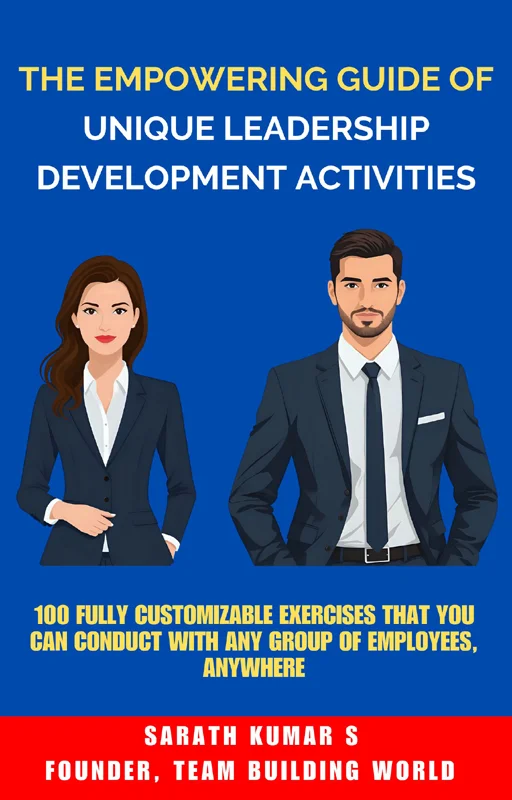10 Leadership Icebreakers for Small Groups
Are you in search of leadership icebreakers for small groups?
Icebreakers are an excellent way to kickstart group dynamics, build rapport, and foster a positive atmosphere. For leaders, icebreakers play a crucial role in creating connections, breaking down barriers, and setting the stage for productive collaboration. Whether you’re leading a team meeting, a training session, or a workshop, incorporating icebreakers can energize participants and enhance their overall experience.
In this article, let’s explore 10 effective icebreakers for your small groups. They will help you facilitate meaningful interactions and create a sense of unity among your team members.
What are Leadership Icebreakers?
Leadership icebreakers are activities designed to break the initial tension in a group setting and encourage open communication. They are particularly useful for small groups because they create a comfortable environment where everyone feels included. These icebreakers help leaders set the tone for the session, establish trust, and promote active participation. The right icebreaker can transform a group of individuals into a cohesive team, ready to collaborate and share ideas
10 Leadership Icebreakers for Small Groups
Here are some leadership icebreakers for small groups that can help you create a positive and inclusive atmosphere.
#1. Two Truths and a Lie
This is a classic icebreaker activity that encourages participants to share interesting facts about themselves while challenging others to identify false statements. It helps them to get creative, share personal information, and learn more about their colleagues.
Time: 10-20 minutes
Materials: None
Participants: 3-8 people per group
Instructions
- Ask each participant to come up with three statements about themselves, two of which are true and one that is false.
- Allow each participant to take turns sharing their three statements with the group, without revealing which one is false.
- After each participant shares, invite the rest of the group to guess which statement they believe is the lie.
- Once everyone has made their guesses, the participant can reveal the false statement and share the story behind it.
Debrief
Discuss how this activity helped the participants get to know each other better. Highlight the importance of being authentic and vulnerable in building connections with others.
You can also read: 10 Team Building Icebreakers for Small Groups
#2. Would You Rather
This is an engaging icebreaker that allows participants to share their preferences. It encourages conversation and debate within the group.
Time: 10-15 minutes
Materials: None
Participants: 3-8 people in a group
Instructions
- Ask each participant to come up with two options for a “Would you rather” question. For example, “Would you rather live in the city or the countryside?”
- Take turns asking each participant’s question and allow everyone to share their answer, followed by a brief explanation.
- Encourage discussion and debate among participants by asking follow-up questions or allowing others to share their perspectives.
Debrief
Discuss how this activity helped the group learn more about each other’s preferences and perspectives. Emphasize the importance of respecting different opinions and finding common ground within a team.
You can also read: 10 Leadership Activities for Small Groups (With Debrief)
#3. All About Me
This icebreaker is a fun and creative way for the participants to share their interests, hobbies, and background with the rest of the group. It helps build connections based on commonalities among team members.
Time: 15-20 minutes
Materials: None
Participants: 3-6 individuals per group
Instructions
- Ask each participant to create a personal collage or drawing that represents who they are, including their interests, hobbies, values, etc.
- Allow everyone to present their collages/drawings to the group and share the story behind each element.
- Encourage discussion and connections among the participants by asking follow-up questions or finding common interests.
Debrief
Discuss how this activity helped create a sense of community within the group. Highlight the importance of acknowledging and celebrating individual differences while finding commonalities to bond over.
#4. Desert Island
This icebreaker challenges participants to think critically, solve problems as a team, and learn about each other’s decision-making process.
Time: 15-20 minutes
Materials: A list of items
Participants: Groups of 3-6 people
Instructions
- Present the scenario to the groups: they are stranded on a deserted island and can only bring 5 items with them.
- Provide a list of items (e.g., food, tools, survival gear, etc.) and ask each group to rank them from most important to least important.
- Allow the participants to share their rankings and discuss why they made certain choices.
Debrief
Discuss how this activity helped the participants understand each other’s priorities and decision-making styles. Emphasize the importance of collaboration and compromise in problem-solving within a team.
#5. One Word
This simple yet effective icebreaker encourages quick thinking, creativity, and communication among team members.
Time: 10-15 minutes
Materials: None
Participants: Groups of 4-8 people
Instructions
- Ask each participant to think of one word that represents themselves or their current mood.
- Allow everyone to share their word with the group and briefly explain why they chose it.
- Encourage discussion and connections by asking follow-up questions about the chosen words.
Debrief
Discuss how this activity helped the participants express themselves in a concise yet meaningful way. Highlight the importance of active listening and curiosity in building strong relationships within a team.
#6. Speed Networking
This fast-paced activity helps participants build connections quickly by sharing key information about themselves in short, timed intervals.
Time: 15-20 minutes
Materials: Timer or stopwatch
Participants: 4-8 members per group
Instructions
- Pair up the participants and give them 2-3 minutes to introduce themselves to each other, sharing key details such as their name, role, and an interesting fact about themselves.
- After the time is up, indicate that it’s time to switch and have the participants rotate to a new partner.
- Continue the process until everyone has had the chance to meet several group members.
Debrief
Discuss how this activity helped the participants establish quick connections and learn more about each other. Highlight the value of networking, sharing insights, and forming relationships in a professional setting.
#7. Team Trivia
This icebreaker fosters teamwork while testing participants’ knowledge in a lighthearted and entertaining way.
Time: 15-20 minutes
Materials: Prepared trivia questions, paper, and pens (optional)
Participants: 3-6 individuals in a group
Instructions
- Split the participants into small teams and give each team a name.
- Ask them trivia questions related to general knowledge, pop culture, or even company-specific topics.
- Allow teams to discuss and write down their answers within a set time limit.
- After each round, share the correct answers and keep a score for each team. Finally, see which team wins.
Debrief
Discuss how the activity encouraged collaboration and communication within teams. Reinforce the importance of leveraging diverse knowledge and skills in group settings.
#8. Collaborative Storytelling
This activity nurtures creativity and teamwork by having participants build a story together.
Time: 15-20 minutes
Materials: None
Participants: 3-6 members in a group
Instructions
- Gather the group and explain that they will be creating a story together, one sentence at a time.
- Start by giving an opening line to set the scene (e.g., “Once upon a time, a group of explorers discovered a hidden treasure map…”).
- Go around the circle, with each participant adding one sentence to continue the story.
- Encourage creativity and humor, but remind the participants to keep the story cohesive.
Debrief
Discuss how this activity showcased different perspectives and ideas while encouraging the participants to think on their feet. Highlight the importance of creativity and collective input in team projects.
#9. Picture Perfect
This icebreaker highlights the value of non-verbal communication and creativity as participants work together to recreate an image or concept without words.
Time: 10-20 minutes
Materials: Pre-selected images or diagrams, paper, and pens
Participants: Groups of 3-6 people
Instructions
- Divide the participants into small teams and assign each team an identical, pre-selected image or diagram.
- One person from each team is chosen as the “artist,” while the rest of the team acts as “communicators.”
- The “communicators” are allowed to look at the image but cannot show it to the “artist.” Instead, they must describe the image verbally to the “artist,” who attempts to recreate it on paper.
- Set a timer and allow the teams to work until the time is up. Once all teams are finished, compare the drawings to the original image and identify the group that came closest.
Debrief
Discuss how this activity emphasized the importance of clear, concise communication and teamwork. Highlight how different communication styles and collaboration techniques can impact the success of a shared task.
#10. Common Ground
This activity helps participants identify shared interests and commonalities, fostering a sense of connection and mutual understanding.
Time: 15-20 minutes
Materials: None
Participants: Groups of 3-6 people
Instructions
- Divide the participants into small groups and ask them to spend a few minutes discussing their hobbies, interests, or experiences.
- Challenge each group to identify at least three things that everyone in the group has in common.
- Encourage the participants to think beyond surface-level similarities and explore deeper connections.
- Afterward, have each group share their findings with everyone.
Debrief
Discuss how this activity promoted conversation and helped the participants discover connections with one another. Reinforce the idea that finding common ground is a key step toward building strong relationships and effective teamwork.
Want Some Unique Leadership Development Activities?
If you want some unique activities to equip your employees with leadership skills, qualities, and mindset, you can get my new e-book:
Or Want Some Unique Team Building Activities?
If you want some unique activities for your employees (both in-person and virtual), you can get my new e-book:
Final Words
Incorporating these icebreakers into your leadership toolkit can help you create an inclusive and participatory atmosphere. This will also help you foster stronger connections and communication within your small groups. Remember, effective leadership goes beyond just managing tasks; it’s about building relationships and empowering your team to thrive. So, get ready to break the ice and unlock the full potential of your group!
FAQ: Leadership Icebreakers for Small Groups
You might have these questions in mind.
Why are icebreaker activities important for small groups?
Icebreaker activities are essential because they help the participants feel more comfortable and relaxed, paving the way for better communication and collaboration. These activities can break down social barriers, build trust, and create a positive environment that encourages teamwork.
Can these icebreaker activities be customized for virtual settings?
Yes! Most of these activities can be adapted for virtual environments with a little creativity. For example, you can use video conferencing tools, virtual whiteboards, and online collaborative platforms to modify activities like Collaborative Storytelling or Common Ground for remote teams.
How do I choose the right icebreaker for my group?
Consider factors like the size of your group, the time available, and the objective of the icebreaker. For instance, if you want to foster creativity, Collaborative Storytelling may be a great choice. If the goal is to improve communication, activities like Picture Perfect can be effective.
Can these activities be used for training sessions or workshops?
Absolutely! Icebreakers are a fantastic way to energize your participants and set the tone for productive sessions. They help participants engage actively with the content and each other, making the experience more impactful.
How can I ensure active participation during icebreakers?
To encourage participation, choose activities that match the interests and comfort levels of your group. Clearly explain the purpose and rules of each activity, and create a judgment-free zone where everyone feels safe to contribute. Positive reinforcement and enthusiasm from the facilitator can also go a long way in boosting engagement.

